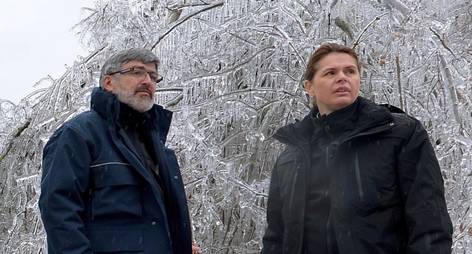NEWS
Slovenia faces the aftermath of large-scale natural disaster
Hoar frost and glaze ice in recent days across most of Slovenia have caused major disruption in electricity supply, which remains the biggest problem in the country besides blocked roads. The region of Notranjska and south-west Slovenia have been the most affected. The Prime Minister Alenka Bratušek, who reviewed the situation on-site, organised a coordination meeting with competent ministers to talk about the natural disaster recovery, discuss the situation and coordinate further work of competent services in order to establish the conditions for normalising life in affected areas. The PM stressed that the utmost priority was the safety of the inhabitants and everyone involved in recovering the situation, restoring the electricity supply to households and the industry, and the operation of transport infrastructure.
At its correspondence session, the Government of the Republic of Slovenia decided to ask for international support and requested higher-power generators via the European Union Civil Protection Mechanism due to the damage caused by sleet in large part of the country. Because Slovenia is unable to provide additional generators, it requested international assistance in order to obtain about 100 higher-power generators (over 100 kW).
Austria, Germany and the Czech Republic responded in record times. Today, Austria will deliver 27 generators between 100–500 kW, two additional generators of 350 kW will arrive from Germany (one has already arrive and has been sent to Postojna), while one generator will be sent by the Czech Republic. The equipment will arrive together with technicians.
Administration of the Republic of Slovenia for Civil Protection and Disaster Relief has already delivered 68 generators to assist individual householder and four higher-power generators in order to ensure electricity supply for water collection points. Slovenian Armed Forces used five of its higher-power generators (125 kW) to provide power to smaller settlements.
The Minister of Defence, Roman Jakič, said that there were 500 tonnes of metal, wires and cables on the ground, 1,781 transformers were not operational, and, according to the latest data, over 140,000 people were without electricity.
Minister Jakič said that the Administration of the Republic of Slovenia for Civil Protection and Disaster Relief would first provide the additional generators to settlements that had been without power for the longest, then to the water collection points, and finally to large consumers, including schools, day-care centres, hospitals and elderly-care centres.
Volunteer fire fighters have been working on field since Friday, while 10,000 people have volunteered to help recover the damage cause by sleet.
The Slovenian Armed Forces (SAF) immediately responded to the situation by providing a helicopter, generators, vehicles and food provision funds and contributing teams to help with disaster relief. SAF will support activities based on a comprehensive disaster relief plan.
According to the estimates of the Minister of Agriculture and Environment, Dejan Židan, the damage caused by heavy snow and icy rain is the greatest natural disaster in Slovenian forests. Multi-annual recovery programme is to be drawn up in three months. Mr Židan stresses that Slovenia will collect the recovery funds, and as these are large sums, we will ask for international assistance.
Road and railway traffic has been disturbed due to heavy snow and sleet, while electricity outages are causing disruption in mobile phone services.
Due to unfavourable weather elements, about 75 per cent of schools and nurseries have been closed.




